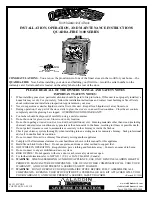
2
List of contents
1.
Description
2
2.
General information,
safety information
2
3.
Data for calculating the chimney
dimensions according to
DIN 4705 Part 2
3
4.
Installation and connection
of the multi-fuel stove
3
4.1.
Safe distances (minimum distances):
3
4.2.
Connection to the chimney
3
4.3
Connection to the heating system
4
5.
Operating the multi-fuel stove
4
5.1.
Suitable fuels
4
5.2.
Installation of the combustion
air regulator
4
5.3.
Using your multi-fuel stove
for the first time
4
5.4.
Lighting the multi-fuel
stove and heating it
5
5.5.
Adding fuel
5
5.6.
Operating methods in
the transition period
5
5.7.
Emptying the ash
5
5.8.
Limiting emissions
5
5.9.
Cleaning and maintenance
5
5.10.
Trouble-shooting
6
6.
Guarantee
6
6.1.
General
6
6.2.
Warranty guidelines
6
6.3.
Complaints
6
7.
Information concerning the ordering
of replacement parts
6
Congratulations!
You are the owner
of a
HAAS + SOHN
multi-fuel stove, a quality product. Please read the operating
instructions carefully. You will find information about how
to use and operate this stove which will enable you to
increase the practical value of the device and extend its
working life. In addition you can save fuel by burning it
correctly and protect the environment. The accompanying
information sheet for the device is a part of these operating
instructions.
We can only provide a guarantee when the following
instructions for the installation and use of your stove are
complied with. Keep these instructions and the device
information sheet in a safe place, so that you can
refamiliarise yourself with the correct operation of your
stove at the start of each heating period.
1. Description
Multi-fuel stoves, which allow water to circulate through
them, are suitable for connection to the sealed central
heating system already present and for the heating of living
rooms and workspaces.
The body of the stove consists of a welded steel
construction. Underneath there is a wood storage shelf.
Above this is there is the ash pan. On top of this there is the
combustion chamber and on top of that the heat exchanger.
The flue for the exhaust gases is placed between the heat
exchanger and the back wall of the inner stove.
Heating of the air in the room and the creation of a
comfortable climate to live in is actually achieved by
convected heat. In this way even rooms which have been
cool for a long period of time can be heated quickly. Air
from the room enters the stove via the wood storage shelf,
becomes heated in the convection duct between the inner
body and the outer wall and flows out again through the
openings on top of the stove. The proportion, which is
radiated heat, is produced by heat radiation from the
transparent window in the combustion chamber door, from
the metal surfaces of the stove and – if they are present –
from the ceramic surfaces on the side walls.
2. General information, safety information
National and European standards, local regulations, planning
and building regulations and fire safety regulations are to be
complied with. When installing your stove you must observe
the fire prevention regulations, the regional planning and
building regulations and also hold a meeting with the
appropriate master chimney sweep in the area. He will also
test to see if the connection of the device to the chimney
complies with regulations.
Before you install your multi-fuel stove check if the load
bearing capacity of the sub-structure can support it. If the
load bearing capacity is insufficient suitable measures must
be taken in order to achieve this (e.g. a plate to the spread
the load).
!
The room in which you install the stove must be
protected against frost and well ventilated!
All tests prescribed by the legal authorities must be carried
out on your multi-fuel stove. The required values for
combustion efficiency and the exhaust gas emissions must be
complied with.
Your multi-fuel stove of type BA 1 is tested according to
EN13240 ‘Room heaters fired by solid fuel’. Multi-fuel
stoves of type 1 (see appliance specification plate) may not
be connected to a multiply-occupied chimney unless the
chimney measurements allow this according to DIN 4705
part 2.
The multi-fuel stove is designed to burn fuels slowly.
Classification as type 1 is achieved by self-closing
combustion chamber doors. The springs that close the doors
may not be removed when any such device is connected to a
multiply occupied chimney. The combustion chamber doors
may only be opened when adding fuel and when removing
the ash. Otherwise they must remain shut, even if the stove is
not being used, in order to avoid affecting other fireplaces
and to avoids the dangers associated with this.
Sufficient supply of fresh air to the room in which it is sited
must be ensured. Windows and doors to the room in which it
is sited should not be closed so tightly that they prevent the
supply of the air necessary for combustion. The minimum
amount of air must be able to flow to your stove without
being prevented by the operation of air extraction devices
(e.g. extractor fans in the bathrooms and kitchen etc.) in your
home or any other dwellings which may be connected to it.
























